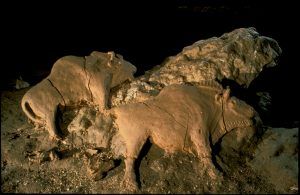Justin E. H. Smith in Art in America:
 There are images on the walls of caves, whether we put them there or not. Or, more precisely, we create images on the walls of caves, whether with charcoal and manganese or simply with our imaginations. Michelangelo’s well-known claim that he simply released from stone what was already there is straightforwardly true of Paleolithic artists. They placed their lines where the contours already suggested animal motion.
There are images on the walls of caves, whether we put them there or not. Or, more precisely, we create images on the walls of caves, whether with charcoal and manganese or simply with our imaginations. Michelangelo’s well-known claim that he simply released from stone what was already there is straightforwardly true of Paleolithic artists. They placed their lines where the contours already suggested animal motion.
When I had occasion to remark early in my cave-art education that the pair of clay bison sculptures (ca. 15,500 years before the present) located in France’s Tuc d’Audoubert cave are relative rarities, since most cave art is painted on the walls, a veteran of the field corrected me. “It’s all sculpture,” she said. It is all “sculpture,” though most of it was done for us by the same natural forces that brought forth the underground spaces hosting the works. The caverns’ many undulations, outcroppings, fissures, and declivities were then enhanced by human hands, and sometimes saliva: as in the common crachis technique of spitting on a surface and then rubbing on the pigments. Other techniques include using water or plant oils as mediums and applying colors by means of pads, brushes, hands, or blowing—either through a tube or directly from the mouth.
More here.
